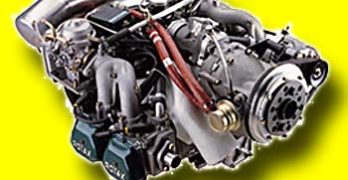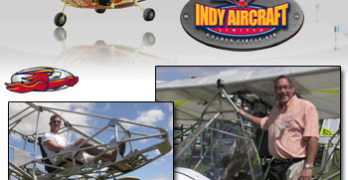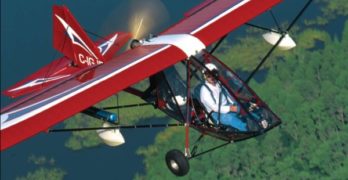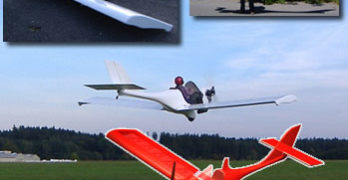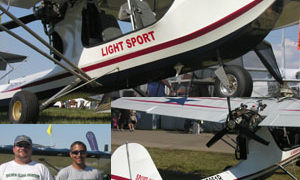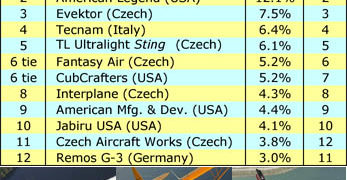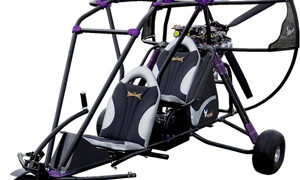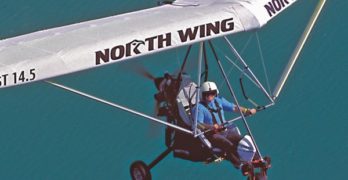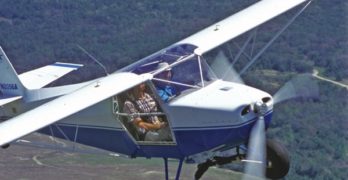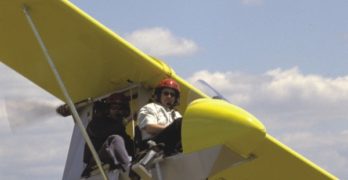No one doubts the leading position of Rotax engines among Light-Sport Aircraft. Of course, most European producers use the Austrian brand, but so do many U.S. builders even including Van’s Aircraft. However, despite their dominance, some GA pilots have scoffed at the brand, saying it isn’t a “real” aircraft engine partly as it didn’t match the 2,000-hour TBO (Time Between Overhaul) common to American brands like Continental or Lycoming. Well, that argument has evaporated. *** Rotax not only upped the TBO on its flagship four-stroke 912 engine, they even made it retroactive. Those following an optional Service Bulletin issued on December 14th can increase the life of the 912 they already own by performing what is essentially a detailed inspection; some older models may require some updates. (Click here for details.) The change applies to the 80-horsepower model, to the the popular 100-horsepower version and to the turbo-charged 914 model as well.
Search Results for : four-stroke
Not finding exactly what you expected? Try our advanced search option.
Select a manufacturer to go straight to all our content about that manufacturer.
Select an aircraft model to go straight to all our content about that model.
Ultralights Seek SLSA Approval; May Sell ELSA Kits
Taking a kit aircraft company to full ASTM approval is a very big decision for small companies. Simply assuring you have documents to support a declaration is, by itself, a major task. Then comes a decision about fully building or going the Experimental LSA kit route. A company must first fully build and certify at least one Special LSA, but once done, they can elect to provide a kit only…or to factory build and supply kits. Small shops could fully build 20-30 SLSA and supply additional ELSA kits and parts to make a healthy business. *** We may finally see such entries. Recently I wrote an updated pilot report on the T-Bird I from Indy Aircraft. Boss Bret Kivell said Indy is working on approval. As an ELSA, the single seater could be HKS (four-stroke) powered, which would make it one sweet sport aircraft. Likewise development is underway at Paul Mather’s M-Squared Aircraft where his Sport 1000 could gain SLSA approval later this year.
Lightplane Offerings From Canada
The Beaver and Chinook ultralight-like aircraft are arguably two of the bestknown
lightweight designs coming from Canada. Aircraft Sales and Parts, more
commonly known as ASAP, is the company that rescued and now manufactures
and sells these designs, along with a powered parachute from its sister company,
Summit Powered Parachutes. The tale of ASAP’s involvement with the Chinook
and Beaver offers insight into ultralight progress – Canadian style.
A History Lesson
Perhaps the most famous ultralight
to come out of Canada is the Beaver.
With a reported 2,200 flying units
since the early 1980s, it’s a successful
design. However, due to corporate
missteps by the companies that
owned the brand, the Beaver series
was nearly lost. Originally, the Beaver
models were manufactured by
Spectrum Aircraft Inc. Reorganization
left the ultralight in the hands
of a company called Beaver RX Enterprises.
In 1993, that company closed
its doors and stranded thousands of
Beaver aircraft owners, along with
all the dealerships that sold and serviced
them.
See Nothing New in Part 103 Airplanes? Look Again!
Even though FAA has said Part 103 will not be changed, many pilots see few fixed wing airplane choices truly meeting the definition.
Some trikes and powered parachutes can manage it but many lament, “Yeah, but no three-axis designs.” If you agree, be prepared to eat your words. Here comes Interplane’s ZJ Viera.
The brand-new composite design is no dream. It’s gone through a proof-of-concept stage and is now flying as a preproduction prototype. Those attending Sebring Expo 2008 can visit importer LSA America‘s display.
Does it genuinely make weight, the toughest part of F.A.R. Part 103? Based on factory info…YES, and by a generous margin!…thanks to modern materials and simple design.
Will ZJ be affordable? “Yes,” says former Interplane owner Ralph Mandarino. The company priced a basic ready-to-fly monowheel ZJ at $19,800. They’re flying it with the Hirth F33 but as it appears well under the max empty weight of 254 pounds, ZJ engineer and Interplane CEO Marek Ivanov could investigate other engines including four-stroke or electric.
Old Becomes New…and Lowers the Cost of LSA
Sport Hornet is the second fixed wing “ultralight” to make the jump to Special Light-Sport Aircraft certification.* Some consider Hornet a “true ultralight” as it uses an aluminum tubing airframe. Builder Higher Class Aviation made numerous changes: The upside-down two-stroke Rotax 582 gave way to right-side-up four-stroke Rotax 9-series engines. Gross weight was increased. New dual struts brace dual wing spars. The cockpit is four inches wider and rear rudder pedals have more room. Conventional toe brakes are available. *** All these things are great but the best news may be base price for a reasonably well-equipped Sport Hornet with the 80-hp 912: $49,995. [UPDATE: 8/29/07 — HCA now gives buyers the 100-hp 912S for the same price!] And one more important thing: since Sport Hornet still flies like most ultralights it can continue to train pilots to fly other ultralight-type aircraft. After the final deadline of January 31, 2010, you’ll still be able to conduct training for hire in a Sport Hornet.
LSA Market Shares Stabilize But Change On Horizon
In the month of July 2007 the LSA industry registered 71 more aircraft bringing the total to 904 fixed wing airplanes. That represents a spurt of 11% in one month and an even 60% growth in registered LSA since January 1st 2007. *** In all categories, Americans are flying 1,134 SLSA. Weight Shift aircraft registered an additional 27 aircraft, powered parachutes added 6 and LSA gliders achieved their first registration. *** The leading companies (see chart) were barely changed with the top five holding nearly identical market share from last month. CubCrafters inched up a notch and Czech Aircraft Works narrowly passed Remos. Further down the market share list, positions still saw little fluctuation. This equilibrium will surely be disturbed with the entry of Cirrus (by August 2008, they say) and Cessna* (in the second half of 2009) but for 27 months, customers have generally kept their brand loyalties. *Cessna reported more than 550 sales in the week of AirVenture Oshkosh.
SLSA Number 50 Is Powrachute’s AirWolf 912
Right at the two year point since the first Special Light-Sport Aircraft approval, Powrachute’s AirWolf 912 powered parachute brings the certified fleet total to 50 SLSA models. Forty two of them are airplanes (the fixed wing variety) with five being weight shift (trikes), and three powered parachutes. Among PPCs, the Canadian Summit II was first in 2006 followed by Infinity’s Commander early this year. *** Team Powrachute loads up their AirWolf 912 with the electric start 100-hp Rotax, a four-blade Warp Drive composite prop with Super Hub, an Electronic Info System with instrument pod, extended footbars, spun aluminum wheels, tundra tires, dual hydraulic main gear suspension paired with springs, stainless exhaust, strobe light, electric fuel pump, dry cell battery, four-point seat belts, oversize canopy carry bag with line socks and a choice of parachute sizes and colors. While some complain about the cost of LSA, here’s one with a four-stroke engine for less than $31,000.
Co-Developing the Navajo Trike
A couple of years ago, TC’s Trikes owner TC Blyth and North Wing owner Kamron Blevins joined forces in a cooperative arrangement. TC’s Trikes would buy wings from North Wing (rather than continue to make their own), and could better represent North Wing on the Eastern Seaboard. North Wing, headquartered in the northwestern state of Washington, is far from TC’s Trikes’ Tennessee home. It seemed a marriage of convenience and more.
Blyth has been particularly active in training and introductory flight lessons. He’s done many thousands of them at his location near a top Tennessee tourist and outdoorsmen attraction – the Ocoee River, popular for white water rafting, kayaking, and other sports. Blyth has been focused on meeting this need with his own brand of trikes, and all his experience gave him something clear and viable to add to the expertise of North Wing.
North Wing has risen to the top of the U.S.
Just Aircraft’s Highlander
If you’re familiar with Avid Flyer or Kitfox aircraft, you know at least something about Just Aircraft’s Highlander. Its pedigree “path” is somewhat meandering but leads to an excellent flying machine born of a rich American airplane design heritage.
Dean Wilson was the originator of this now-proven design shape. The first departure from Wilson’s Avid Aircraft company was Dan Denney, who went on to offer the Kitfox. Denney’s prowess as a marketer brought international fame to the Kitfox and, over the years, the sale of nearly 3,000 aircraft. At one time Denney Aerocraft was among the country’s largest suppliers of kit-built aircraft. What had been an ultralight design evolved into a successful 2-seat homebuilt, but that wasn’t the end of the evolution behind Wilson’s original creation. Denney sold his company to Phil Reid, who renamed the Idaho company SkyStar.
A Well-Evolved History
Another break-off from Avid Aircraft and Denney Aerocraft was Flying K Enterprises, which introduced the single-seat Sky Raider.
The Lil’ Breezy B-Model
Open-Cockpit 2-seater
ust when you felt as though Light-Sport Aircraft (LSA) was the only segment of aviation getting any press, along comes a flying machine that harks back to the early days of ultralighting but with a distinctive fuselage construction and composite wings.
Just when it seemed like every new LSA had to be enclosed, four-stroke-powered, fast, and have leather seats, along comes a new open-cockpit, mile-a-minute airplane that can easily carry two people on the power of a 50-hp Rotax 503. The leather is on your flight jacket.
The Lil’ Breezy B can weigh 350 pounds empty, fly at 60 mph, and sell for $12,500 (for all parts plus engine/prop but not your assembly labor). In my experience that sounds like an ultralight. Born in the new millennium, the Lil’ Breezy B is a modern ultralight.
Before we go fly, let’s examine the machine and talk to its developer, Jack Harper.
- « Previous Page
- 1
- …
- 6
- 7
- 8
- 9
- 10
- …
- 13
- Next Page »


